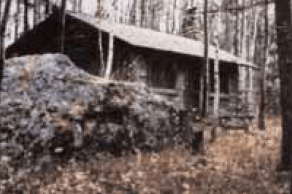
Grey with age, flanked by a granite chimney, nestled in the woods beside a great moss and lichen covered boulder, the little cabin looks like part of the scenery itself, private, remote from the world of man and machine, of clocks and watches, a haven of peace and quiet. Yet, the little cabin was produced by the turmoil and tensions of its own time almost fifty years ago. And, although hidden at the base of a rocky point of land on Burntside Lake near Ely in far away northwestern Minnesota, it is, perhaps, the most famous and photographed cabin in the country. The story of Listening Point goes back to the days when the President’s Committee for the Quetico-Superior was fighting for the Air Ban, the buy-out of resorts on the border lakes, and the framing of a national Wilderness Bill in Congress. Tempers on both sides had been worn raw from years of local opposition to what was seen as outside interference in their country, their livelihoods while the iron-range mines were beginning to shut down. The bitter battle raged between friends, families, communities, north and south, east and west, from the media to Congress, to the courts, and to national politics. By 1956 the Canadians were involved. It was a time when Sig Olson, working with the President’s Committee for the Quetico-Superior, was on the front lines both in Ely and in Washington, D.C.
It was a time when Sigurd Olson sought for some sanctuary away from the conflict and turmoil. He was being vilified in the press and shunned on the streets of his own town. During 1956, he hiked the country around Ely in his spare time looking for a quiet place where he could remember and experience again what he had loved and sought to preserve of the North Country and his own soul. He eventually found it on “a bare, glaciated spit of rock” on the south shore of Burntside Lake near Ely. In a very real sense, his search was pilgrimage, the last pages of a lifelong story of the search for his own holy grail. So that he wrote about it and what it meant to him in his second book. He titled the book Listening Point after the name he chose for the land itself, because, he wrote, “only when one comes to listen, only when one is aware and still, can things be seen and heard.”
He did not mean for Listening Point to become famous, but it has been from the beginning and has remained so ever since. Indeed, Listening Point has become the Walden Pond of the North, beloved by generations. It has become a place of pilgrimage to others. People come alone, with friends, with families, and in groups, always with awe and respect.
It was not surprising that, after his death, the preservation of Listening Point became a popular cause and concern. As a result, family
and friends established the Listening Point Foundation, Inc. in 1998 to which the family then donated the property. The object of the
Foundation is twofold: to preserve the natural and historic integrity of Listening Point for the pleasure and education of future generations, and to continue Sigurd Olson’s life work of wilderness educations.
The years of work between Sig and the Quetico-Superior Committee and its successor, the Quetico Superior Foundation have continued into the era of Preservation. After many years, the little cabin began to need repair, especially with the roof where the picturesque shakes were on the verge of disintegration. It was a job that had to be done but, for the fledgling Listening Point Foundation, an expensive one. It appealed for help and, in 2001, the Quetico Superior Foundation provided the much needed funding. That, plus the volunteer
work of three young men from Hayward, Wisconsin, did the job. Now, thanks to them and the Quetico Superior Foundation, the little cabin will continue to speak quietly about the wilderness for those who come to listen.
This article appeared

